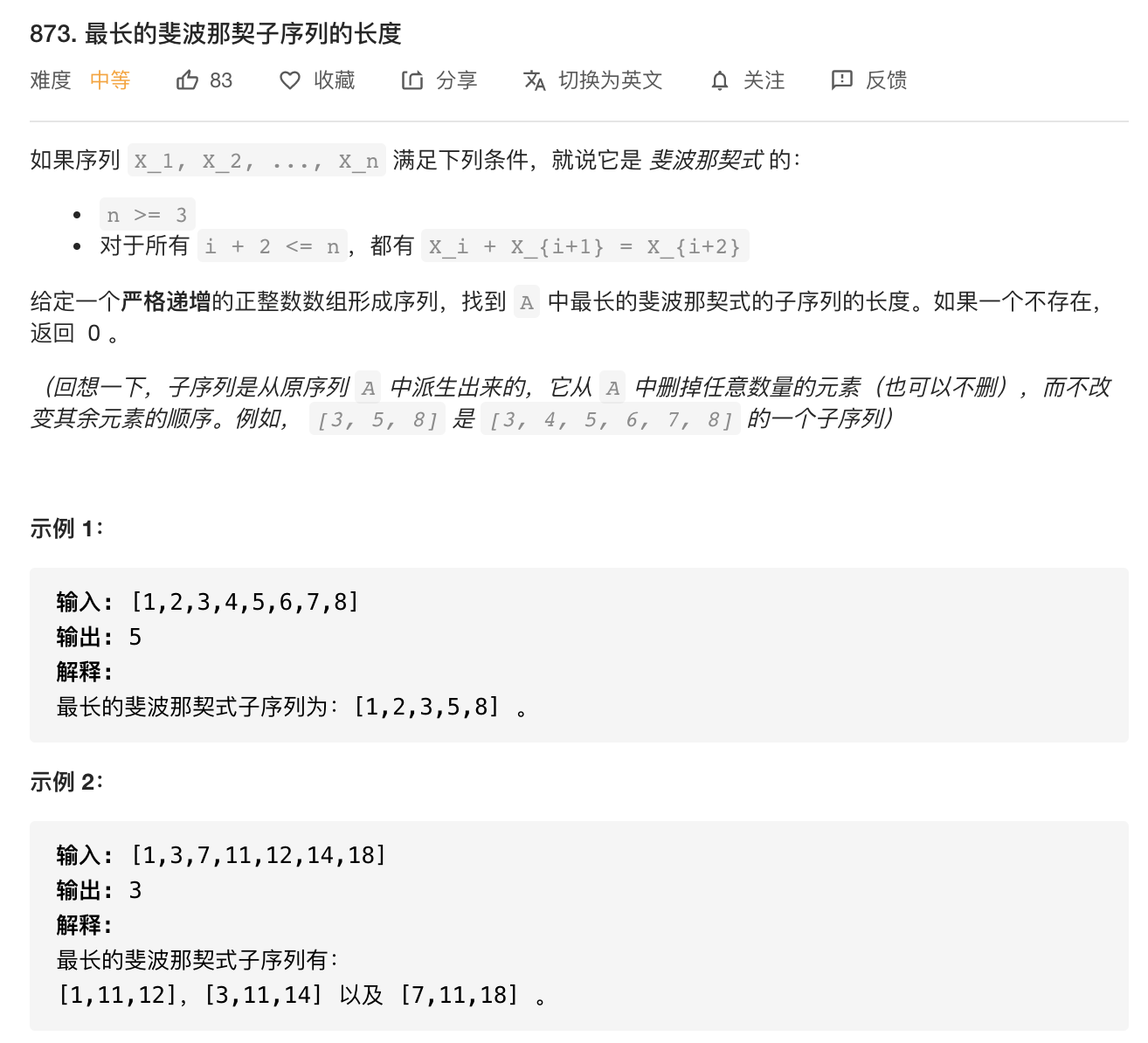
记忆化递归:
int max = 0; public int lenLongestFibSubseq(int[] A) { int[][] cache = new int[A.length][A.length]; for (int i = 0; i < A.length - 1; i++) { for (int j = i + 1; j < A.length; j++) { lenLongestFibSubseqDP(A, i, j, cache); } } return max; } /** * @Author Niuxy * @Date 2020/6/28 10:08 下午 * @Description 想要确定一个斐波那契数列,需要确定头两个元素 * 因此要遍历数列中所有的两两组合,求出以其作为头元素和第二个元素的斐波那契额数列的长度,取最大值 * G(f,s) 为以下标为 f,s 的元素为头元素与第二个元素的斐波那契数列长度 */ public int lenLongestFibSubseqDP(int[] A, int f, int s, int[][] cache) { if (s == A.length - 1) { return 2; } if (cache[f][s] != 0) { return cache[f][s]; } int next = A[f] + A[s]; for (int i = s + 1; i < A.length; i++) { if (A[i] != next) { continue; } int re = lenLongestFibSubseqDP(A, s, i, cache) + 1; max = max > re ? max : re; cache[f][s] = re; return re; } cache[f][s] = 2; return 2; }
转为递推即为 DP:
/** * @Author Niuxy * @Date 2020/6/28 11:35 下午 * @Description DP 解法,将递归转为递推 */ public int lenLongestFibSubseqDP2(int[] A){ int[][] cache=new int[A.length][A.length]; for(int i=0;i<A.length;i++){ cache[A.length-1][i]=2; } for(int i=A.length-2;i>=0;i--){ for(int j=i+1;j<A.length;j++){ if(cache[i][j]!=0){continue;} int next=A[j]+A[i]; for(int k=j+1;k<A.length;k++){ if(A[k]==next){ int re = cache[j][k] + 1; max = max > re ? max : re; cache[i][j] = re; } } cache[i][j]=cache[i][j]==0?2:cache[i][j]; } } return max; }
借助 hash 表剪枝:
public int lenLongestFibSubseqDP2(int[] A) { int max = 0; int[][] cache = new int[A.length][A.length]; Set<Integer> aSet = new HashSet<Integer>(); for (int i = 0; i < A.length; i++) { cache[A.length - 1][i] = 2; aSet.add(A[i]); } for (int i = A.length - 2; i >= 0; i--) { for (int j = i + 1; j < A.length; j++) { if (cache[i][j] != 0) { continue; } int next = A[j] + A[i]; if (!aSet.contains(next)) { cache[i][j] = 2; continue; } for (int k = j + 1; k < A.length; k++) { if (A[k] == next) { int re = cache[j][k] + 1; max = max > re ? max : re; cache[i][j] = re; } } cache[i][j] = cache[i][j] == 0 ? 2 : cache[i][j]; } } return max; }
基于剪枝及DP的思路,重写优化:
public int lenLongestFibSubseq(int[] A) { int N = A.length; Set<Integer> S = new HashSet(); for (int x: A) S.add(x); int ans = 0; for (int i = 0; i < N; i++) for (int j = i+1; j < N; j++) { int x = A[j], y = A[i] + A[j]; int length = 2; while (S.contains(y)) { int tmp = y; y += x; x = tmp; ans = Math.max(ans, ++length); } } return ans >2 ? ans : 0; }
